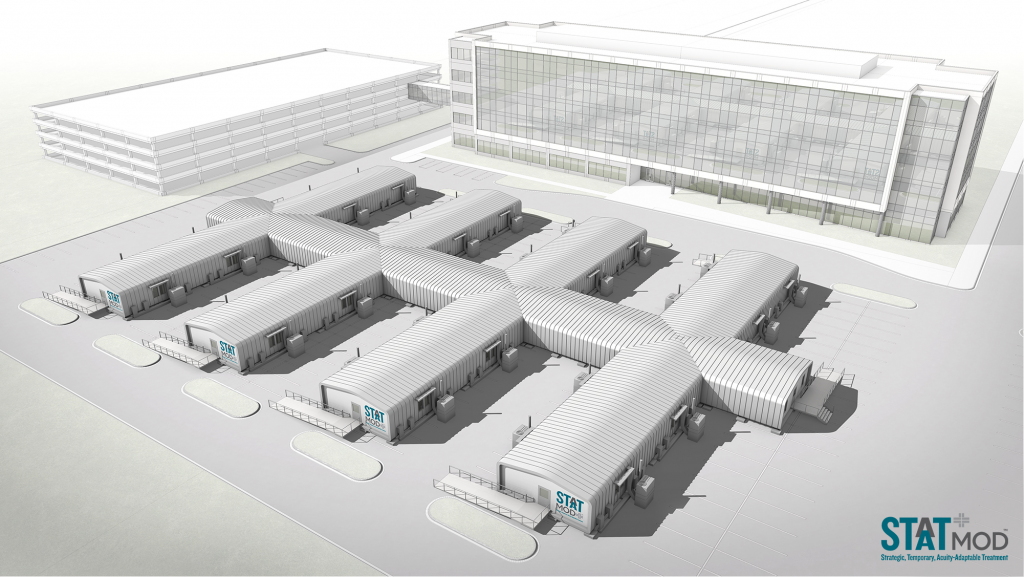Company Designs COVID Care Facilities
Prefabricated facilities designed to connect to hospitals and can provide hospital-level care.
A design firm has developed a prefabricated care facility that can be deployed to add hospital bed capacity during the COVID-19 pandemic.
It’s called the STAAT MOD, which stands for Strategic, Temporary, Acuity-Adaptable Treatment. It was designed by HGA, an architecture and engineering design firm based in Minneapolis. HGA’s second largest office is located in Milwaukee with over 165 employees.
These prefabricated facilities can be set up as free standing care facilities or can be connected to existing hospitals and care facilities. They can also be assembled inside a large convention center.
As the country prepares for a surge in COVID-19 cases over the next month or so, additional hospital capacity is built out wherever possible. In Milwaukee County, the state, in partnership with Milwaukee County and the Army Corps of Engineers, is building an alternative care facility in the Wisconsin State Fair Park Exposition Center.
According to a press release from HGA, these units provide hospital-level critical care with isolation rooms that meet the Center for Disease Control (CDC) guidelines regarding airborne infectious diseases like the coronavirus. It also includes segregated work space to reduce healthcare workers contact with the virus.
The facilities come in three configurations. One is a two-room isolation unit. Another is an eight-bed critical care unit. And the third is a larger configuration with negative-pressure bays that have three beds each.
The modules are designed to connect to each other or existing hospital facilities so that capacity can be continuously updated as needs change. Prefabrication of the units allows for faster construction.
HGA partnered with The Boldt Company, a national contractor, as well as Tweet/Garot, Faith Technologies and IMEG on the project.
In a statement, Dave Kievet, Chief Operating Officer for The Boldt Company, said their production can meet aggressive schedules because they have standardized production with the modules that easily connect to each other and existing hospital facilities.
If you think stories like this are important, become a member of Urban Milwaukee and help support real, independent journalism. Plus you get some cool added benefits.
More about the Coronavirus Pandemic
- Governors Tony Evers, JB Pritzker, Tim Walz, and Gretchen Whitmer Issue a Joint Statement Concerning Reports that Donald Trump Gave Russian Dictator Putin American COVID-19 Supplies - Gov. Tony Evers - Oct 11th, 2024
- MHD Release: Milwaukee Health Department Launches COVID-19 Wastewater Testing Dashboard - City of Milwaukee Health Department - Jan 23rd, 2024
- Milwaukee County Announces New Policies Related to COVID-19 Pandemic - David Crowley - May 9th, 2023
- DHS Details End of Emergency COVID-19 Response - Wisconsin Department of Health Services - Apr 26th, 2023
- Milwaukee Health Department Announces Upcoming Changes to COVID-19 Services - City of Milwaukee Health Department - Mar 17th, 2023
- Fitzgerald Applauds Passage of COVID-19 Origin Act - U.S. Rep. Scott Fitzgerald - Mar 10th, 2023
- DHS Expands Free COVID-19 Testing Program - Wisconsin Department of Health Services - Feb 10th, 2023
- MKE County: COVID-19 Hospitalizations Rising - Graham Kilmer - Jan 16th, 2023
- Not Enough Getting Bivalent Booster Shots, State Health Officials Warn - Gaby Vinick - Dec 26th, 2022
- Nearly All Wisconsinites Age 6 Months and Older Now Eligible for Updated COVID-19 Vaccine - Wisconsin Department of Health Services - Dec 15th, 2022
Read more about Coronavirus Pandemic here





















